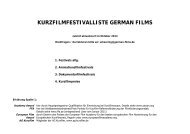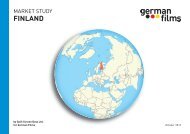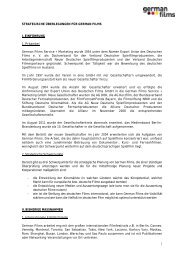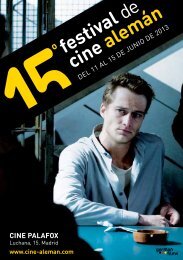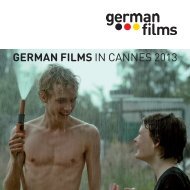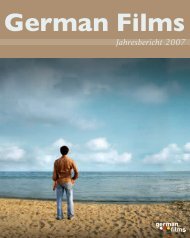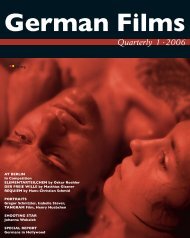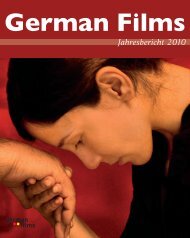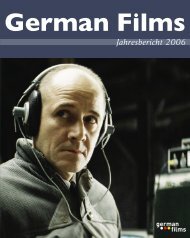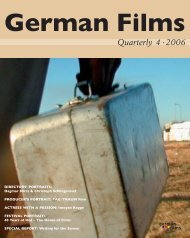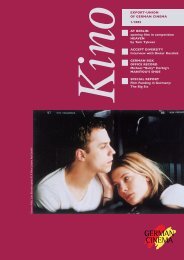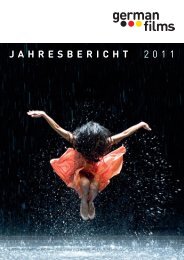Titel Kino 2/2001(2 Alternativ) - German Films
Titel Kino 2/2001(2 Alternativ) - German Films
Titel Kino 2/2001(2 Alternativ) - German Films
You also want an ePaper? Increase the reach of your titles
YUMPU automatically turns print PDFs into web optimized ePapers that Google loves.
FILM ARCHIVES AND FILM MUSEUMS IN THE FEDERAL REPUBLIC<br />
Erich Kettelhut (Metropolis), Robert Herlth and<br />
Herbert Kirchhoff. The designs by the DEFA set architect<br />
Alfred Hirschmeier are stored at the Film Museum<br />
Potsdam, drawings by Walter Reimann (Das Cabinet<br />
des Dr. Caligari) and Otto Hunte (Die Nibelungen)<br />
in Frankfurt. The archive material is available for viewing in the<br />
museums by previous arrangement, and the museums lend<br />
out originals for exhibitions by acknowledged institutions at<br />
home and abroad; for all other users (for example for book<br />
reproductions), slides or photos may be made in exchange<br />
for a certain fee.<br />
The museums have not limited their acquisition activity to the<br />
Federal Republic. The estates of directors and actors in particular<br />
are often kept with their heirs in other countries. In 1993,<br />
the SDK acquired a superlative collection for five million<br />
marks: the estate of the actress Marlene Dietrich, which<br />
had been kept in various storage houses in Europe and the<br />
United States. The “Marlene Dietrich Collection<br />
Berlin” now administrates this unique collection illustrating a<br />
life whose highlights are shown by the Film Museum<br />
Berlin. The Collection first presented parts of the estate in<br />
the exhibition “<strong>Kino</strong>*Movie*Cinema” in Berlin during 1995,<br />
after this as an individual exhibition in Bonn and Rome, and<br />
from 1997 onwards, a small section went on its travels as a<br />
touring exhibition to the Goethe Institutes. In 1997, the<br />
<strong>German</strong> Film Museum Frankfurt was able to take<br />
over the estate of Curd Jürgens, which had been housed<br />
in the south of France, where the star lived until his death.<br />
In Frankfurt, a focus on (west) <strong>German</strong> post-war film has<br />
emerged together with the Artur Brauner Archive –<br />
the film documentation of the Berlin producer.<br />
Restoration<br />
and reconstruction<br />
Metropolis Theater (photo © Kinemathek Hamburg)<br />
During this year’s Berlinale, film historians from all over the world<br />
waited excitedly for one screening: the “premiere” of Fritz<br />
Lang’s silent film classic Metropolis (1927). Several archives<br />
had worked together on the reconstruction of this under the<br />
overall control of the Friedrich-Wilhelm-Murnau<br />
Foundation. Within the <strong>German</strong> archive scene, the name<br />
Enno Patalas, the former director of the Film Museum<br />
Munich, is connected with Metropolis, since he has often<br />
worked on this film. His reconstruction of classic silent films like<br />
Murnau’s Der brennende Acker or Paul Wegener’s<br />
Golem and his lecturing activities have meant that in recent<br />
years those members of the public interested in film have<br />
developed a greater awareness for silent movies.<br />
Important reconstructions by the archives in recent years include<br />
Robert Wiene’s Orlacs Hände, G.W. Pabst’s Die<br />
freudlose Gasse and Tagebuch einer Verlorenen,<br />
Lubitsch’s Anna Boleyn, Paul Wegener’s Der Golem,<br />
wie er in die Welt kam or Lotte Reiniger’s silhouette<br />
film Die Abenteuer des Prinzen Achmed.<br />
The reconstruction of films can only succeed if several archives<br />
work together. This is not only true of the preparation of film<br />
copies, but also of research work. Traces of a film – such as its<br />
screenplay, censorship certificate or musical score, which are all<br />
important for a reconstruction – are often scattered in various<br />
places. Contact to the international association of archives FIAF,<br />
founded in 1938, is also of eminent importance, for an export<br />
version stored abroad has often proven to be more complete<br />
than the one preserved in <strong>German</strong>y.<br />
Emigration and Holocaust<br />
The absorption of film into the propaganda apparatus of the<br />
Nazis and the exodus of Jewish film artists after the so-called<br />
”take-over of power“ is the heaviest burden of guilt to be borne<br />
by <strong>German</strong> film. An investigation into the consequences of<br />
National Socialist film policy is one of the most important<br />
Editing Room (photo © Film Museum Munich)<br />
themes for the archives and the museums in <strong>German</strong>y – at least<br />
this has been the case during the last two decades. The SDK in<br />
Berlin has collected together the probably largest collection of<br />
materials on <strong>German</strong> film emigration, in particular to Hollywood.<br />
Its nucleus are the estate and business documents of the film<br />
agent Paul Kohner, who was the first person approached by<br />
many emigrants during the Nazi period.<br />
In 1987, the <strong>German</strong> Film Museum Frankfurt assembled<br />
the touring exhibition “From Babelsberg to Hollywood: Film<br />
Emigration from Nazi <strong>German</strong>y”, which was a great success in<br />
11



